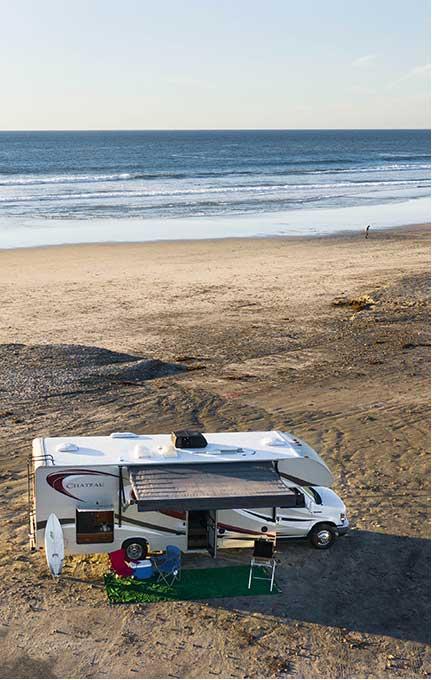You’re planning for a glamping trip, and someone recommended you to try yurts. If you’re from a Western country like me, you probably have no idea what a yurt is. I didn’t know either until I tried one for myself.
As it turns out, glamping in a yurt was perhaps the best decision I made. Once you learn about this minimalistic accommodation setting, you’ll appreciate the beauty.
A yurt is a temporary structure made from wool felt draped over a wooden structure. It’s very much like a tent except that yurts are circular in shape and are far more stable. Modern yurts, like the ones designed for glamping, can have multiple rooms with partition walls and an ensuite bathroom.
But above all, it is the cultural significance that makes yurts different from all other accommodation options. Many people in Central Asia live in yurts and call them their homes to this day.
In the subsequent sections, learn more about these structures and how you can build one for yourself. And if you’re planning a Glamping adventure, be sure to stock up on hiking and camping gear before you roll.
RVs For Rent Near You
Yurts History: From Mongolia to America
Yurts are not a recent makeshift accommodation arrangement invented by campers. They’ve been around for a long time — like really long.
Yurts originate in Central Asia. Nomadic Mongolian and Turkic tribes erected these structures at the resting places before moving on to a new location.
The word ‘Yurt’ may sound like a new yogurt brand. But it means home, homeland, or dwelling place in many nomadic languages. Mongolians call it ‘ger’ while the Russians refer to it as ‘Yurta.’ Yurt in the western world is derived from this Russian term.
The first written records of yurts are found in the book Historia. The Greek historian Herodotus wrote it in the fifth century BCE. The book, which is regarded as the founding work of history in literature, mentions tent-like dwellings inhabited by Scythians.
Scythians were a nomadic group in central Asian steppes who moved from shifted bases on wagons.
During the nomadic era, yurts were prevalent in most parts of central Asia. It is said that Mongolian ruler Genghis Khan ruled the empire while living in a large yurt instead of a palace. Apart from Mongolia, they were prevalent in regions that are today known as Kazakhstan, Kyrgyzstan, and Turkmenistan.
The yurts were introduced to the United States in the 1960s. It was William Copperthwaite who pioneered yurt building in the country. He read an article on Mongolia on National Geographic, which sparked his interest in yurts. He has written extensively about the tent-like structures in his books.
What is the Purpose of a Yurt?
Today, yurts have multiple purposes. But during the nomadic era, they only had one purpose: to provide shelter.
As already mentioned, yurts mean home or dwelling in many nomadic languages. When the nomads moved around searching for food and water, they had no options for where to spend the night. There was a considerable risk from invaders and wild animals.
To solve this problem, they developed yurts, which were like semi-temporary homes. It was easier to set up and disassemble. They carried the yurts along with them. It is very much like the camping of the modern era, except that it was their permanent and only home.
Traditional yurts were made from sheep wool, yak hair, or whatever material was available to them. Multiple layers of the wool provided the much-needed insulation. The layers were supported by a wooden framework that was sturdy enough to last long.
In recent times, yurts are used as ‘yurt quarters’ in cities like Ulaanbaatar. This is like a community made up of yurts. So safe to say, yurts (or ger, as they call it) are still very popular in Mongolia.
In the Western world, yurts are used for recreational purposes. Many companies have started offering yurt camping and glamping services. You can stay there for a night or weekend and closely experience the Central Asian nomadic lifestyle.
Do Yurts Have Bathrooms?
Most people are concerned about the sanitary aspect of glamping. So when going on a yurt glamping trip, they often wonder if the yurts would have bathrooms.
Most, if not all, modern yurts have bathrooms. As opposed to the old Mongolian yurts, these are permanent structures. They are not dismantled and transferred to another location the next day.
So companies invest in them just like real estate. They spend thousands of dollars to include modern amenities like TV and fridge.
But the thing to note is that the bathroom can either be attached to the yurt or located in an outdoor location. When the bathroom is attached to the frame, it’s marketed as ‘Yurt with ensuite bathroom’. The bathroom is like any other partition of the yurt. It’d most likely have toilets, basics, a shower, and a mirror.
When the bathroom is outside the yurt, you’d have to walk down some distance. Depending on the company, it can either be a personal or shared bathroom.
But if you’re purchasing a yurt, keep in mind that they won’t come with a bathroom or toilet. You’d have to add them with the help of interior designers and plumbers. Or you can build the bathroom as a separate entity.
Either way, you’d have to spend some extra money. But from a sanitation point of view, it’s well worth it.
Why are Yurts So Popular?
Pacific Yurts was the first company to start producing yurts in the US. The company was established in 1978 to cater to glamping enthusiasts. Since then, the yurts have been growing in popularity, not only in the US but all over the world.
A report released by Airbnb suggests that interest in yurts after the pandemic has surged about 1,700% in the US alone. So it’s worth asking why yurts are so popular among campers and glampers.
A straightforward answer can be that they’re in trend. People want to experience something different and are willing to spend a few nights in the yurts. But that’s just one of the many reasons.
The popularity of yurts can be attributed to the following factors:
- They have rich cultural significance
The main reason for the yurt’s popularity is perhaps the fact that they have high cultural significance. And consumers are valuing it.
Yurts have a nomadic heritage and an integral part of Central Asian society. The yurt’s crown, which is called ‘Shangrak,’ is itself emblematic. While the yurt was repaired and rebuilt, the Shangrak stayed the same. It was passed down generations from father to son.
The length of the family’s heritage was measured by how blemished the Shangrak looked. Today, the crowns are at the center of the emblems of many Central Asian countries.
The traditional yurts were also heavily decorated with cultural symbols and geometric designs. These represented the local flora and fauna and the cultural values of that time.
Because of such cultural significance, yurt construction was officially named a UNESCO Intangible Cultural Heritage in 2013.
Today, when people spend time in a yurt, they are transported back in time. They get an opportunity to experience what it might have been like for the Central Asian nomads of the fifth century BCE.
It is this curiosity that’s driving the popularity of yurts.
- They’re environment-friendly
Another reason for their popularity is that they’re good for the environment. In these times when climate change is a global concern, people are looking for eco-friendly options.
First and foremost, the yurts are made on a wooden framework. Wood is eco-friendly and breaks down easily after use.
The next thing that makes yurts environment-friendly is the circular design. It maximizes interior space and uses less construction material. So there’s less fabric used.
The third reason is that yurts are built on a beam platform and not directly on the ground. So when they’re moved to another place, they leave little behind and do not adversely impact the land.
So it’s safe to say traditional yurts are good for the environment.
Yurt manufacturers are taking one step further and using recyclable materials for the fabric. Pacific Yurts derives 25% of the manufacturing energy from renewable sources.
These things appeal to the end consumer, which helps drive their popularity.
- They’re profitable
The third reason for the popularity is the business side of things.
Whenever something is popular, chances are it is profitable as well. For example, at the peak of its popularity, fidget spinner manufacturers were making $2.6 million per month from sales of the toy.
The glamping industry itself is growing fast. And it is expected to grow at a CAGR of 14.1% through 2028.
Companies are investing in yurts because they’re unique, affordable, and durable. There’s minimal cost involved in setting it up. Moreover, the maintenance cost is on the lower side as well. Since the yurts tend to last long, the ROI for businesses is enormous.
Because of the low cost, glamping enthusiasts buy their own yurts and set them up in their backyards. This further increases its popularity.
RVs For Rent Near You
{“odcTracking”:”What is a Yurt? – From Origins to Todays Glamping Superstar”,”rentalPageType”:”pin”,”odcLocale”:”en-us”,”partnerId”:”700″,”apiObject”:{“auto_radius”:true,”instant_book”:true,”pagination”:{“pageSize”:4}}}A Yurt vs. a Tent? What’s the Difference?
Both yurts and tents are temporary collapsible structures. They’re portable and easy to set up anywhere. But there are some fundamental differences between a yurt and a tent.
The significant differences are the structural differences.
As already stated, yurts are made with a circular wooden frame with wool or felt as the covering. The structure consists of lattice wall sections, roof poles, door frames, and a crown. Furthermore, there are more than one ropes that hold the frame together. The felt served as the covering and provided the insulation.
On the other hand, tents are made with stakes and poles as the framework. There’s no wall section involved.
So when compared to tents, yurts are far more sturdy. A yurt in Japan even survived a tornado when nearby houses collapsed.
Yurts are also far more secure against wild animals. A bear or fox may tear a tent into pieces, but they can’t possibly pull down the wooden walls.
The unique roof construction is another discernible feature of the yurts. You will find a chimney-like open space in the middle in both traditional and modern yurts. Traditionally, this was intended to direct smoke out of the yurt.
Nomads had to use wood for cooking and often cooked inside their yurts. The smoke generated was dispersed into the atmosphere through this opening. In modern yurts, the opening serves as the skylight and lets sunlight come inside the structure. It also aids in air circulation.
Tents do not have any openings on the roof and are closed from all sides.
That being said, there are some other noticeable differences between yurts and tents worth considering.
- Yurts offer more space, thus more comfort
Tents are set up for camping purposes. People on a camping or trekking trip usually need a place to spend the night.
But yurts are much more than that. They are dwelling places intended for families. People used to live, cook, and sleep inside the yurts. Therefore, they tend to be more spacious.
Today, the yurts are available in varying sizes. Some of them are as small as a tent. But the yurts marketed as Mongolian ger are big enough to have room for a kitchen and bathroom.
Since glamping requires a spacious accommodation setting, yurts are the ideal option.
- Yurts have cultural significance; tents don’t
As described earlier, yurts have rich cultural significance and are named an Intangible Cultural Heritage.
So when you’re stepping inside a yurt, you’re stepping inside something unique. You have an opportunity to live like a Central Asian nomad for a day. This is something no other accommodation setting can provide.
- Yurts have better spatial quality than tents
Because of their circular shape, yurts have better spatial quality than yurts. In architecture, spatial quality is defined as the overall configuration of physical elements and how they affect the landscape.
William Coperthwaite, in his book, noted that the yurts are unimposing and blend effortlessly into the surroundings. They have a low profile (as they’re not very tall), a covered roof, and a wall of weathered pine. All of this allows the yurt to blend into the environment naturally. Therefore, when placed in a forest setting, they feel natural.
Tents feel artificial because of their sharp edges and heavy use of ropes. They don’t promote the feeling of being in harmony with nature.
This is something William Coperthwaite liked about yurts the most.
What Is A Yurt Made Of?
Traditional yurts (or gers) were made from wood walls and layers of felt. The felt is made from beaten sheep wool or yak hair. The crushed wool/hair is then dipped in sheep’s milk or fat to make it waterproof. However, the materials and exact design vary from region to region.
Modern yurts retain the overall structure of the ger. They use a sturdy wooden platform and a post-and-beam frame (made of either wood or metal) for the base. The felt is replaced with waterproof vinyl canvases. Some manufacturers like Pacific Yurts provide NASA-developed reflective insulation for better comfort.
Along with that, you’re going to find the following features in a modern yurt:
- French doors
- Dome skylights
- Glass windows
- Gutter systems
- Ceiling fans
- Electric sockets
- Heating and cooling systems
Modern yurts can also be customized to suit your needs. For example, you can install a central column to increase the snow load capacity. It is recommended for snowy conditions. Other than that, it’s possible to install interior walls, electrical appliances, and even lofts.
How to Build a Yurt?
Yurts are now cheaper than ever. The price may go down even further with innovation in construction and material. But that shouldn’t deter you from building your own yurt if that’s what you’ve been planning to do.
Building a yurt is challenging and requires some skill set. But there are DIY yurt kits available that make the process easier. You can set up a yurt within an hour or two.
It’s recommended that you purchase a kit to build your yurt. It should come with the following pieces:
- Base – The base serves as the foundation for the yurt. In modern yurts, the base is circular in shape and can be a wooden platform or a deck.
- Lattice wall – Lattice walls are also circular and made from wood. You may get a single-piece wall or multiple pieces that you’d have to join to get the circular shape.
- Crown – The crown sits at the top and is partially open. You may receive a decorative or a regular crown, but that’s not a concern since both deliver the same functionality.
- Rafters – These are also wooden structures that sit on top of the lattice wall and form the yurt’s roof.
- Door frame – These wooden frames are meant to support the door. You’d also receive window frames if the yurt supports them.
- Covering – The covering is the canvas you’d have to drape around the wooden structure. You may get multiple layers of canvas. Along with that, the kit should include a canvas door, crown cover, roof cover, and roof band.
Once you have the kit and all the key constituents, get started with building the yurt. Here are the steps you need to follow:
- Build the base
The first step is to build the circular base. Select a flat surface as your foundation and place the base on it.
But if you’re building a permanent or semi-permanent structure, the soil is not the best foundation. That’s because water can seep in during rain. You need elevation to counter it.
So you’d have to construct a raised deck that matches the yurt’s footprint. You can also build a concrete footing. But it is likely to require permits from the local authorities.
- Install the door frame and the lattice wall
Once the base is ready, the next step is to take care of the door frame and the lattice walls.
Before you set the wall up, decide the direction of the door. If your platform is elevated and has steps, the door should be right in front of the steps.
After securing the door, take out the lattice wall and stretch it along the perimeter. Once you reach the other side, fasten the joint with the metal straps included in the kit.
The kit should also have a wire cable. Take it out and run it through the top of the lattice wall along the perimeter. The cable will provide strength and stability to the yurt.
- Install the rafters
After the wall, you’d have to erect the roof. So take out the rafters to install them.
Each rafter will connect to the compression ring and then slide over the wire cable. So ask someone to be in the middle to stabilize the compression ring while you attach the rafters to it.
When all the rafters are attached, the compression ring will distribute the weight evenly.
- Cover the yurt
You’ve successfully built the yurt’s framework. Now it’s time to cover it.
For this, you’d have to arrange a ladder. Place it in the middle of the yurt, directly under the compression ring.
Now take the roof cover out and walk up the ladder. From the inside of the compression ring, throw the cover out while holding one end. Ask your friends on the ground to fold it till the roof is covered.
Similarly, put on the wall cover and door cover. Wall covers come in sections and are easier to install. The kit should have more information on how to install the particular cover.
- Install the lighting
The yurt is now complete, and it’s time to decorate it. Assuming that you want electricity within the yurt, you need to make arrangements for the wires. Make sure the cables are brand new and haven’t sustained cracks.
If not wires, you can use battery-powered lamps and candles for the lighting.
Your yurt is now complete. Everything you do from here on (like installing a bathroom or drainage system) is an add-on.
How much does a yurt cost?
The cost of the yurt depends on several factors like location, the size, the fabric, and the company that sent you the kit. But as a rough estimate, the cost will range somewhere from $6,000 to as high as $37,000. This figure doesn’t include any customization. Custom-built yurts demand a bigger budget.
Please note that the costs fluctuate with seasonality. You may have to pay less just before the holiday season when companies run promotional offers.
If you don’t want to buy a yurt, consider renting one. It’ll be cheaper to do so and you can also avoid the liabilities that come with owning a yurt.
That being said, yurts are future-proof and well worth the investment. Whether you’re purchasing them for the next glamping trip or your backyard, they’ll stand the test of time.








